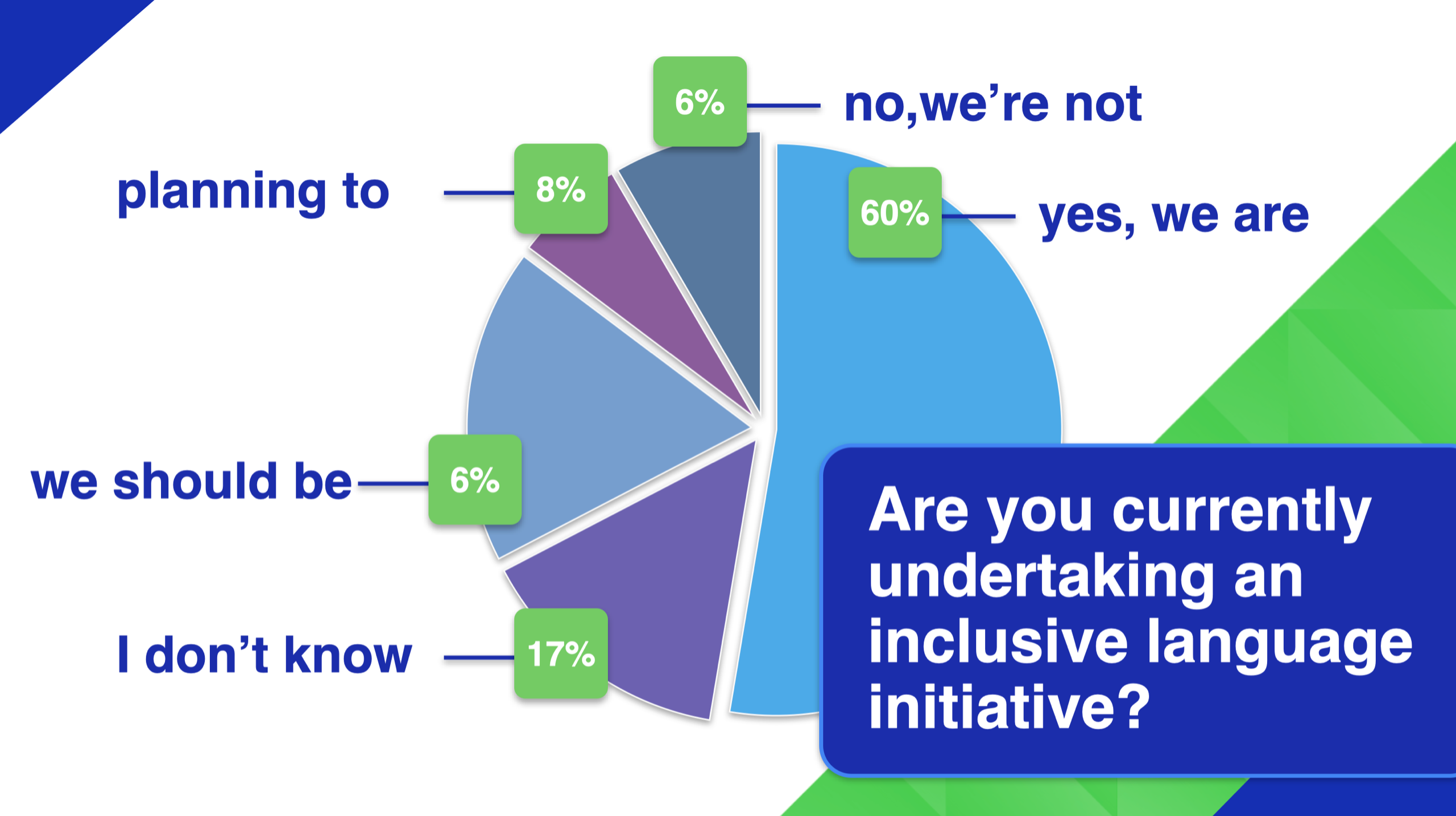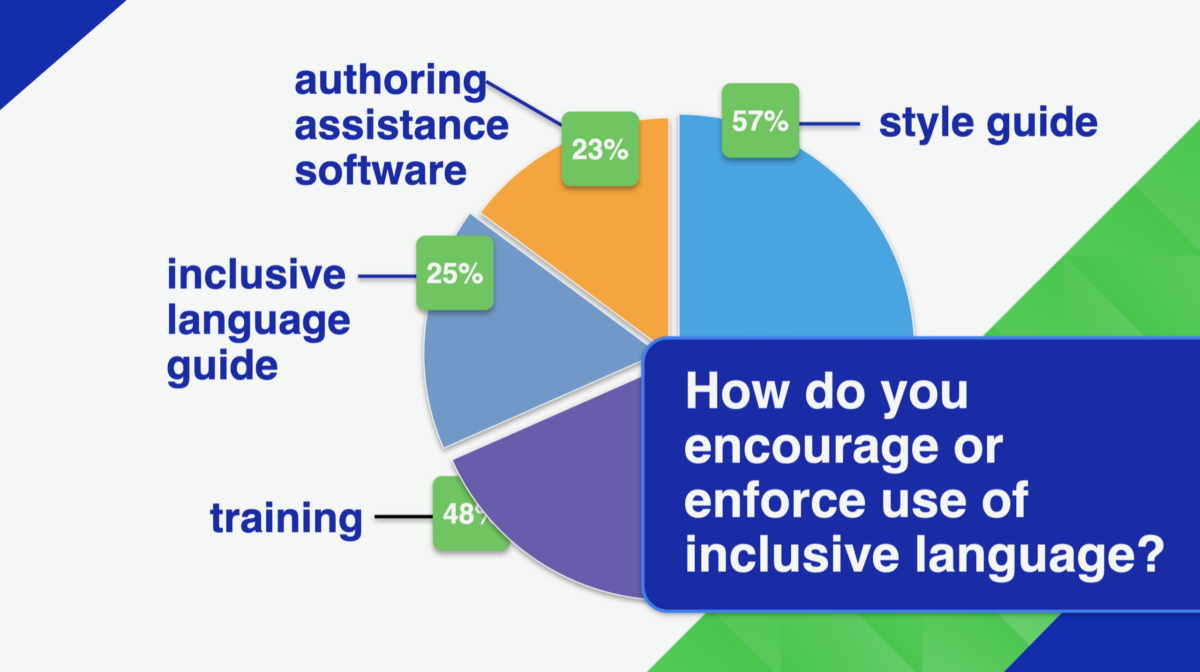Summer 2023
Best Practices for Inclusive Language Use
 Scott Abel, Content Strategy Evangelist, Heretto
Scott Abel, Content Strategy Evangelist, Heretto
Inclusive language is a hot topic today. Companies, educational institutions, professional organizations, trade unions, government agencies, and non-profits worldwide are updating internal and external communication policies, training, and style guides to help employees produce more inclusive language.
What is inclusive language, anyway?
Inclusive language means intentionally choosing words wisely in everyday communication to show respect to everyone. When we opt for inclusive language, we recognize and appreciate each person’s varied backgrounds and identities.
This approach can make people feel valued in the workplace and motivate them to contribute effectively. Introducing inclusive language can help change opinions about mis- and under-represented groups. It’s essential for fostering a positive, inclusive work environment that promotes well-being.
Inclusive language might not be second nature, even for those who appreciate and aim for diversity. It requires practice and a humble approach. Training yourself to avoid using less-than-inclusive words involves making deliberate terminology choices that create spaces where individuals feel valued and respected.
Amusement parks, writing resource providers, dictionary publishers, religious organizations, television networks, credit unions, environmental protection groups, and art museums are involved in moving inclusive language efforts forward. So too, are some religious institutions, member organizations, and trade associations.
While this is good news to advocates for diversity, equity, and inclusion, some people are not keen on adapting language to acknowledge and honor every person’s diverse and intersectional identities.
Religiosity, level of education, geographic location (distance from a central metropolitan area), and level of employment all play a role in whether someone is likely to be comfortable using gender-fair, inclusive language.
Those uncomfortable with the global move toward more inclusive language headline many contemporary news stories.
For instance:
- Legislators in Brazil pushed a bill through their government prohibiting the use of inclusive language in projects that receive government funding.
- In Mexico, some linguists say introducing gender-neutral variants in Spanish damages the language and, potentially, the culture.
- Conservative political characters in India expressed their frustration and anger about inclusive language adoption after they learned that the Cambridge Dictionary revised the definition of “man” and “woman” to include transgender people.
The updated Cambridge Dictionary definitions:
Man: An adult who lives and identifies as a male though they may have been said to have a different sex at birth.
Woman: An adult who lives and identifies as a female though they may have been said to have a different sex at birth.
- Others disapprove of language transformations surrounding inclusive terminology about pregnancy and reproduction rights.
- Editorialist, Nichol Kristof, writes in The New York Times that revising terminology “to be more inclusive is counterproductive and ends up inviting mockery and empowering the [political] right.”
- Meanwhile, in Florida, the state’s governor, Ron Desantis, has defunded all diversity, equity, and inclusion programs at state universities, which he called a “distraction from the core mission.”
- And on her first day serving as Governor of the State of Arkansas, Sarah Huckabee banned the word ‘Latinix” from official state communications.
How many organizations are supporting the inclusive language movement?
Despite the often disproportionately loud voices of inclusive language detractors, sixty percent of organizations today have an inclusive language initiative in place, according to a 2023 survey of over 700 professional knowledge workers (folks whose job primarily involves creating, processing, managing, or using information and knowledge rather than performing manual labor).

Of the organizations with an inclusive language program in place, half of them are company-wide. The other half are siloed team efforts limited to a specific department, according to data from the survey conducted by The Content Wrangler in conjunction with Content Science and the Center for Information Development Management (CIDM).
What motivates organizations to adopt inclusive language?
Motivations for adopting inclusive language vary — as do organizations’ approaches to adopting and consistently applying inclusive language principles.
The survey found that in most organizations, adopting inclusive language aims to reinforce diversity and inclusion as core values central to their culture (84%).
Other top reasons for adopting inclusive language:
- It’s the right thing to do (73%)
- To amplify communications and ensure language relates to the broadest audience possible (60%)
- To help attract new employees and ensure they feel respected, valued, and comfortable to be their authentic selves (44%)
- To help retain existing employees by enabling everyone to contribute diverse perspectives and feel like they belong (43%)
- To encourage better knowledge transfer and decision-making (24%)
What approaches do organizations use to encourage inclusive language?
How organizations approach implementing inclusive language programs and encouraging (or enforcing) compliance with inclusive language rules varies from formal to ad hoc strategies. The less effective teams use manual writing and editing processes, while operations-minded teams leverage machine learning-powered, content-checking software to encourage and enforce guidelines.

Organizations rely on a mix of approaches to encourage inclusive language adoption today:
- Including inclusive language guidance in an existing style guide (57%)
- Training writer’s editors to spot (and replace) less-than-inclusive words with inclusive language (48%)
- Providing specific guidance in a dedicated inclusive language guide (25%)
- Using software to spot problematic language and encourage the use of inclusive language (23%)
Why might the style guide approach not be as effective at encouraging inclusive language as authoring assistance software?
Many organizations publish a style guide encouraging writers to produce consistent content and comply with content rules. It’s advantageous to capture style, brand, tone of voice, and language guidelines and make them available in a single digital guide. But, it’s impractical — and error-prone — to rely on writers to produce content and expect them to check their writing against the rules simultaneously.
Relying solely on a style guide (and a content quality checklist) to ensure we produce inclusive content is not a best practice. Attempting to prevent less-than-inclusive content is more likely to be successful when we employ software tools that understand our content quality, style, grammar, punctuation, branding, tone of voice, and inclusive language rules — and can guide authors away from mistakes writers and editors make.
It’s a far-fetched notion that writers and editors can read a style guide one day and then remember all the rules the guide contains and apply them as they work — while they simultaneously attempt to navigate digital disruptions and overcome everyday distractions.
No one believes a style guide is a practical approach to preventing uninclusive language. It’s an indefensible solution, yet, it’s the most common method used in more than half of all organizations that adopt inclusive language today.
Reliance on software that understands inclusive language rules (something 23% of organizations say they do) encourages using appropriate language while reinforcing the rules, teaching content creators to avoid using less inclusive words and phrases.
What software products support the creation of inclusive language content?
- Acrolinx (enterprise version; browser extension, additional features)
- Writer (enterprise version; browser extension, additional features)
- Grammarly (enterprise version; browser extension, app, additional features)
- Witty (enterprise version browser extension, additional features)
- UInclude (browser-based; inclusive job advertisement creator)
- Alex (browser-based copy-and-paste checker)
- Casey (browser-based copy-and-paste checker)
- Microsoft Editor (works across Microsoft software products)
- Textio (inclusive job listing recruitment checker)
- Better Allies Slackbot (workspace inclusive language checker)
What Are the Benefits of Inclusive Language Checking Software?
The two primary benefits provided by software that ensures compliance with inclusive language guidelines are:
- Real-Time Assistance — suggests more inclusive alternatives or flags potentially problematic language choices on-the-fly
- Contextual Suggestions — provides more tailored and relevant suggestions for inclusive language, ensuring that language choices align with the specific context
AI-powered authoring assistance tools that check for inclusive language rules compliance apps can learn and improve over time. They can become more accurate and nuanced in their suggestions for inclusive language the more we use them.
Obtaining Budget for Inclusive Language Software
Anecdotes collected during follow-up interviews with respondents to the previously referenced 2023 Inclusive Language Survey point to budgeting as one of the primary challenges that many writing teams must hurdle to find the money to purchase software to help guide authors toward more inclusive language. Content creation teams need cash to cover the adoption of language checking and assistive authoring tools.
Technical documentation and information development team leaders who participated in the 2023 survey offered creative suggestions for locating the funds to purchase inclusive language tools. The most successful of which involves finding what technical content experience manager Thersa Cornwell describes as “finding where the inclusive language budget is hiding.”
Cornwell suggests starting with an investigation. “Find out if HR cares about inclusive language because chances are pretty good that they are working to build a more inclusive workforce, and using inclusive language is an essential ingredient in any diversity, equity, and inclusion initiative. You may find they are dialed in on the topic’s importance but have no idea that software tools exist to help the organization meet its inclusive language goals.”
“The approach takes work and sometimes more time than you might like. We had to wait until the next budget cycle to create our combined budget request, and it also took some effort to educate and recruit some champions along the way,” Cornwell says.
Others who participated in the post-survey interviews suggested that leaders in customer satisfaction and customer experience are potential sources of funds to purchase inclusive language-checking software.
Training is helpful, but there are better ways to encourage the adoption of inclusive language
Risks associated with relying on training to encourage or enforce inclusive language rules include two human characteristics:
Overconfidence bias is when we think we know more than we do or believe we are better at something than we are. Resistance to change is our natural state as humans. We prefer to keep things the same because our brains like doing things a certain way.
Our brains love habits. Changing how we think about language choices and which terms are appropriate makes the brain work harder. Inclusive language training involves developing new habits, something that takes additional effort our brains would instead use for other purposes.
Our brains are also fearful. Change is often seen as threatening or uncertain, causing our amygdala to activate and induce feelings of anxiety or fear, making us resistant to change.
We are less likely to recognize our errors, deficiencies, or areas for improvement. We may assume that because we believe in equality and fairness, the words we choose are free from bias.
We may also be less receptive to training during which we receive feedback about our writing from others. Another human characteristic that can get in the way is our desire to avoid uncomfortable conversations, like those brought into relief by inclusive language initiatives.
Five Best Practices to Consider When Adopting Inclusive Language
- Develop clear and accessible guidelines accessible: Ensure our writers can easily access the policies and tools they need to help them apply the rules consistently. Build a process for augmenting or adapting our practices, as the inclusive language landscape is ever-changing.
- Provide practical and relevant examples: Provide examples and carefully-crafted explanations of why specific language choices are inclusive — or not — to help our writers develop a deeper understanding, allowing them to make informed language choices beyond simple, inclusive language rule adherence.
- Include a list of preferred terms and phrases. Be mindful of cultural references (this is where etymology comes in). Watch for (and replace) masculine generics like job titles (foreman, congressman, policeman) and collective nouns (man, guys, mankind, manpower).
- Regularly review and update rules: Language norms and cultural sensitivities change. Reviewing and updating our inclusive language rules and guidance is best to ensure it remains inclusive and aligned with evolving practices. As part of this effort, empower your team to provide open and honest feedback and suggestions for improvement. A culture of continuous learning, feedback, and progress is our goal.
- Engage diverse stakeholders: Seek feedback and diverse perspectives to ensure language choices are inclusive, respectful, and resonate with different identities and backgrounds.
- Commit to gender-neutral language: Be mindful of gender assumptions and biases in our language. Opt to use gender-inclusive terms and avoid gender-marking. Make space for non-binary gender identification in the words you choose
Additional considerations when adopting inclusive language
Word lists: Decide whether to include the contested list of better words. Some people think an inclusive language guide (regardless of whether it is a stand-alone document or part of a corporate style guide) should contain a list of allowed and prohibited words. Some folks argue against the approach; doing so, they say, grossly oversimplifies language.
Images that accompany text: It’s insufficient to limit your focus on inclusivity to text. Graphics, photos, and drawings can all benefit from being mindful of image selection. Ensure the images you select (whether produced in-house or licensed from an inclusive stock photography, illustration, and graphics shop) are inclusive and that they support your text. Be cautious when using artificial intelligence-powered image generation tools, and look out for unintended inclusion-related complications.
Machine translation can introduce bias: Inclusive language is nuanced and multifaceted. Implementing it at scale is largely language-dependent. Gender-neutral translations take work to get right.
Machine translation (MT) systems tend to produce masculine word forms and stereotypical gender associations, reinforcing bias and reiterating the under-representation and misrepresentation of specific groups.
Binary assumptions in language models representing most romance languages introduce obstacles to creating inclusive machine-translated content. Gender-neutral rewriting (a form of transcreation) is often needed to address this shortcoming.
Be prepared for incidental discoveries: Inclusive language programs involve taking an honest and critical look at the words we use to craft our content. Expect incidental discoveries. Try to capture lessons learned and schedule time to tackle additional improvement opportunities. Factor the value of these unexpected improvements (not part of your original project focus) in your return on investment calculations.
Inclusive Language Resources
Educational organizations, non-profits, government agencies, and companies of all shapes, sizes, and configurations worldwide share inclusive language best practice guidelines on the world wide web. A quick web search finds various resources — from practical suggestions for everyday communication to tips for improving inclusive language at work and recommendations for specific industries and disciplines.
Here’s a list of potentially helpful websites that provide valuable information to those working to adopt more inclusive language:
- The Guardian/The Observer Style Guide
- The University of British Columbia Writing Guidelines
- Preferred Language When Talking About Addiction (US National Institute of Health, National Institute on Drug Abuse)
- Guidelines for Nonhandicapping Language (American Psychological Association)
- Race and Ethnicity Inclusive Language Guide (Office of Human Rights, Washington, DC Mayor’s Office on Racial Equity)
- National Association of State Art Agencies (US)
- BuzzFeed Style Guide
- LGBTQ+ Inclusive Terminology (Gay and Lesbian Alliance Against Defamation)
- Inclusive Language for Medical & Health Education
- Inclusive Language, Race, and Ethnicity (American Medical Association)
- 18F Content Guide (US Government Services Administration)
- The Diversity Style Guide (for media and communications)
- Disability Language Style Guide
- The Conscious Language Guide (empowering language)
- Socioeconomic Status Guide (American Psychological Association)
- Transgender and Non-Binary People Medical Care Guidelines (University of California San Francisco)
About the author: Scott Abel serves as Content Strategy Evangelist at Heretto. He also runs a consultancy called The Content Wrangler, which helps companies improve how they author, maintain, manage, and deliver technical product information to those who need it, when, where, and how they prefer it. He writes regularly for content industry publications, produces a series of content strategy-focused books for XML Press, and is a dynamic presenter often featured at content industry events worldwide.

